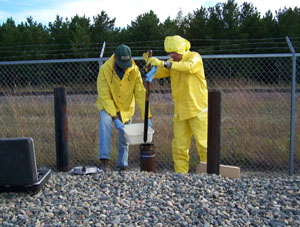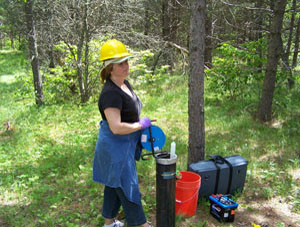Minnesota Water Science Center

Minnesota PROJECTSABOUT THE MINNESOTA
|
Project Title: Fate and Transport of Petroleum Hydrocarbons in Ground Water, Cass Lake, Minnesota 
Statement of Problem:Water Science Center and NRP staff continues research by studying crude-oil contamination beneath the Enbridge Energy Corporation’s Cass Lake pumping station area. The site is within the Reservation of the Leech Lake Band of Ojibwe (Band) and is about 25 miles for the Bemidji research site. The glacial outwash aquifer beneath the site consists of moderately well-sorted fine to medium-grained sands and silts to a depth of greater than 40 ft. Depth to the water table generally ranges from 26 to 29 ft below land surface. Ground-water movement is generally from northwest to southeast toward a wetland and a stream Water-table gradients are about 0.03 – 0.1 percent. Slug tests conducted indicate a mean hydraulic conductivity of about 20 feet per day. The ground-water flow velocity is estimated to be about 30 feet per day with an effective porosity of 0.25. Total organic carbon content of the aquifer matrix is 920 micrograms per kilogram. A network of wells was installed to monitor water quality at the site and to aid in evaluating the extent and nature of the contamination. In addition, a series of push-probe holes were used to investigate the extent of the dissolved and free-phase plumes. Approximately 48,000 gallons of crude oil were estimated to be floating on the water table at the site and crude-oil thicknesses were greater than 1.0 foot in selected wells. The floating crude oil extends to the southeast. The density of the crude oil varies from 0.85 to 0.938 grams per cubic centimeter. The wide range in viscosity and density likely is a reflection that crude oil resulted from batches of oil. The floating oil is estimated to be moving at a rate of 0.5 feet per year. Current remediation at the site consists of bailing oil from the monitoring wells, with a total of about 2.5 gallons being removed each month (Wenck Associates, 2006). Objectives:The objectives of this study are to: (1) Delineate the plume of dissolved petroleum hydrocarbons at the South Cass Lake pumping station in three dimensions; (2) Characterize the redox zones in the Cass Lake plume and use this to evaluate the depletion rate of the natural attenuation capacity of the aquifer; and (3) Estimate ground-water recharge to evaluate the possible effects of focused recharge on enhanced biodegradation of petroleum hydrocarbons. The study approach is to use the push-probe technique to investigate a series of vertical profiles at increasing distance down gradient, followed by field gas chromatograph (GC) to quantify BTEX concentrations, and then use these results to evaluate the existing well monitoring network 
Relevance and Impact:This proposed project is relevant to the USGS mission by addressing the priority issue “Fate and transport of anthropogenic compounds through hydrologic systems.” The proposed studies, based on long-standing USGS research at the Pinewood, Minnesota site would extend the results and fill in the gaps of previous data collection studies conducted by Enbridge and its consultants. Comparison of the research results from the Cass Lake site to that at the Pinewood site will expand our knowledge of the behavior of contaminants at petroleum hydrocarbon spill sites and thus benefit the scientific community. Progress and Significant Results Since Last Reporting Date:The U.S. Geological Survey (USGS) investigated the natural attenuation of petroleum hydrocarbons at the Enbridge Energy Limited Partnership South Cass Lake Pumping Station, in Cass Lake, Minnesota. Three weeks of field work were conducted between May, 2007 and July, 2008 to delineate the dissolved plume of benzene and characterize the biodegradation processes. Field activities included the installation of monitoring wells; collection of sediment cores, sampling of wells, and measurement of water-table elevations. Analytical results consist of grain-size distributions and concentrations of spilled and pipeline oil constituents, dissolved alkylbenzenes and redox constituents in groundwater, sediment bioavailable iron, and aquifer microbial populations. Groundwater flow was determined to be east-southeast at approximately 23 meters per year (m/yr). Results from the oil analyses indicate a high degree of biodegradation characterized by nearly complete absence of n-alkanes. All of the Cass Lake oil samples are highly degraded compared to two oil samples collected in 2008 from the similarly-contaminated USGS Bemidji, MN, research site located 40 kilometers (km) away. To determine if the Cass Lake oil came from the same source as the Bemidji oil, the Cass Lake pipeline sample was compared to an archived Bemidji source oil sample. Based on nineteen ratios developed for comparing oil sources, the conclusion is that the two oils are from the same source. 
In the groundwater plume, benzene concentrations decrease by three orders of magnitude within 150 meters (m) downgradient from the floating oil body (between wells MW-10 and USGS-4 well nest). The depths of the highest benzene concentrations increase with distance downgradient from the oil, which is typical of plumes in shallow, unconfined aquifers. Background groundwater is nearly saturated with oxygen, whereas groundwater in the plume is almost entirely anaerobic. Like the Bemidji site, the most important biodegradation processes are anaerobic and dominated by iron reduction. The similarity between the Cass Lake and Bemidji benzene degradation rates, redox conditions, and aquifer material all support a hypothesis that the Cass Lake plume is decades old. As concentrations of alkylbenzenes in the oil decrease over time, the benzene concentration in the groundwater plume will also decrease and eventually the plume is expected to shrink. Predicting the length of time required for the dissolution rate to slow to the point where the plume begins to shrink is a topic of active research at the Bemidji site. The Fox Creek wetland, located about 250 m south of the Cass Lake site, is the nearest receptor (building, surface water, or wells) south of the Cass Lake site. Based on data collected during this study and results from the Bemidji research, neither the dissolved plume nor the floating oil body is an immediate threat to the environment of Fox Creek or other receptors. Plans for Next Reporting Date:Publish the final report and present findings to the Leech Lake Band of Ojibwe |